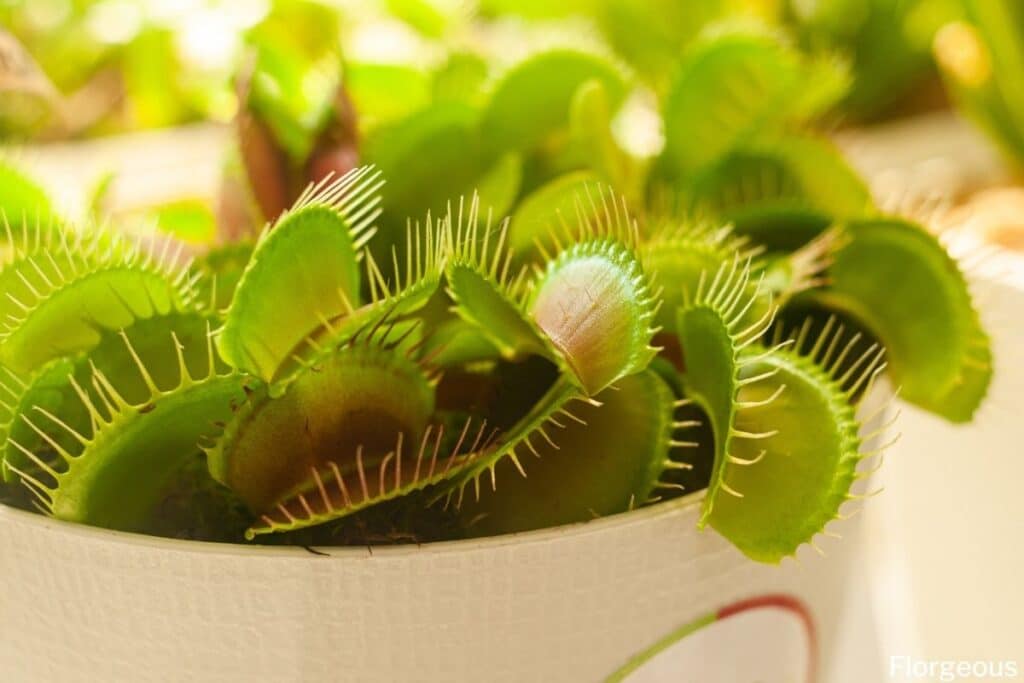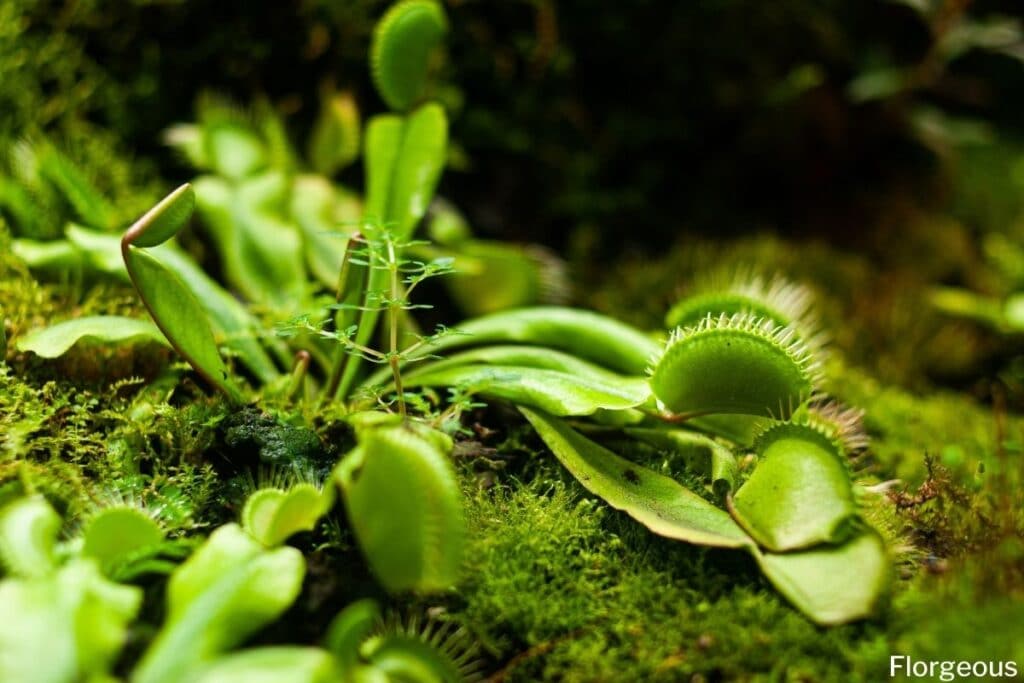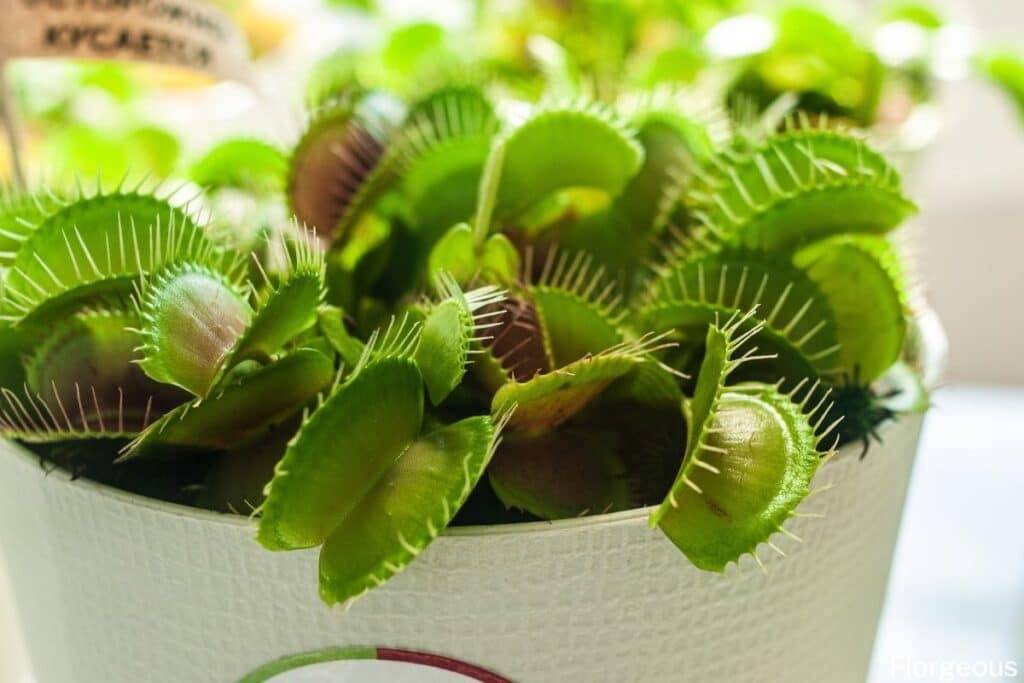Venus flytraps (Dionaea muscipula) have a reputation for being difficult to care for. It’s true that they do need some maintenance, but provided you understand a few important things, you should have no trouble keeping these fascinating carnivorous plants healthy. Read on to learn everything you need to know.
The Venus flytrap is probably one of the most popular carnivorous plant types on the planet. These dwarf perennial herbs are better known for their insect-catching ability than their pretty white flowers. They are native to the Southeastern USA where, sadly, they are becoming increasingly rare in their natural range.
Venus flytraps are rosette plants that produce 4-7 leaves from an underground stem. The leaves themselves are complex structures that attract insects with nectar that bugs find irresistible. These incredible leaves can snap shut in just 1/10th of a second, capturing insects that are then digested for nutrients.
The flattened area between the stem and the trap is in fact the petiole, and this is used for regular photosynthesis. The special adaptations that make these plants so fascinating and unique are vital for an existence in a pretty hostile environment. Understanding this is the first step towards caring for these killer plants.
Plant Facts
| Scientific name | Dionaea muscipula |
| Common names | Venus flytrap |
| Family | Droseraceae |
| Plant Type | Carnivorous houseplant |
| Height and Width | 18 inches tall (indoors), 6 inches wide (indoors) |
| Origin | Wetland areas in North and South Carolina, USA |
| Flower colors | White |
| Foliage color | Green, red |
| Sun Exposure | Some direct sunlight |
| Soil Type & pH | Light, moisture-retaining soil that is completely nutrient and mineral deficient, acidic |
| Special features | Carnivorous plant |
How to Grow a Venus Fly Trap
While venus fly traps do make excellent houseplants, they are in all honesty, much better suited to outdoor life. There are two reasons for this. Firstly, these plants need plenty of direct sunlight, and secondly, they need to go through an annual dormancy period of at least 4 months.
The good news is that these conditions can be recreated indoors. Read on for further details.

Propagation
Venus flytraps can be propagated in a number of different ways. In the traditional sense, they can, of course, be grown from seed. These plants are self-fertile, so it is possible to produce viable seeds from a single plant.
They can also be propagated vegetatively (asexually), and this is a much faster way of producing sizable plants. This can be achieved by preparing leaf pullings, or even from the cut-off flower stalks.
Fortunately, healthy plants will naturally split and produce new rosettes. These can be removed from the parent plant once large enough and repotted in their own container.
Soil
Venus flytraps are specialized plants that need a specific type of soil. The key requirement is that the Venus fly trap soil must be in nutrient-poor soil. Another important quality is that the soil should be light and airy, rather than compacted.
This type of soil is commercially available as a carnivorous plant soil mixture, or if you prefer, you can mix up your own growing medium. The ideal components of this soil type are silica sand, perlite, peat, and sphagnum moss.

Pruning
Venus flytraps are small, slow-growing plants that do not need to be managed for size. Naturally, their leaves do have a limited lifespan, so you may wish to remove dead leaves to keep your plant looking neat.
Unless you’d like to produce seeds, or really wish to see this plant in flower, preventing the plant from flowering is generally advised. This may sound a little unnatural, but the fact is that flowering uses a lot of energy, and can be quite a setback to the plant’s growth.
Be sure to use a clean, sharp cutting tool to limit damage to the plant and prevent the spread of disease between your plants.
Repotting and Transplanting
The root system of the Venus flytrap is not extensive but it does grow deep, and these plants do not enjoy being root-bound. For this reason, these plants do best in a relatively large container in relation to their size. They also need consistently moist soil, and this is another good reason to avoid using very small pots.
You should repot this species once a year or so, and your choice of container material is also very important. Just as you should select a growing medium without nutrients and minerals, it’s important to note that the container can also leach minerals into the soil. Plastic and fully glazed containers are safe, but be sure to avoid clay and terracotta materials.
The ideal container will have drainage holes, be a light color that does not heat up in the sun, and be carefully rinsed off with distilled water to remove any residual nutrients or minerals.

How to Care for Venus Flytraps
With the right care, the Venus flytrap can live for several decades as a fascinating houseplant.
One important thing to note is that the traps of this plant are not able to open and close very many times, so touching them frequently will eventually prevent them from being able to catch prey. Here’s what to know when it comes to venus fly trap care:
Water
These plants are naturally adapted to grow in moist, saturated environments so they will need to be regularly watered. The ideal watering method is to place your plant’s container in a shallow tray containing an inch (2.5cm) or so of water. This way, the soil will remain moist while the plant and its crown are protected from rot.
More important than the way you water this species is the type of water that you provide. Just like they need nutrient-deficient soil, these plants also need water that contains no minerals and nutrients. Therefore, distilled, rainwater, or reverse osmosis water should be used.
Sunlight
The Venus flytrap is a species that needs plenty of light. Growing venus flytraps next to a south-facing sunny windowsill where it can get a few hours of direct sunlight would be suitable. About 6 hours of sunlight would be ideal.
That being said, if you don’t have access to direct sunlight, it is certainly possible to grow these plants under strong grow lights. These plants can be quite sensitive to sudden changes in light, so implement any moves gradually, especially if you pick up a plant that has been kept in deep shade. You can do this by increasing the plant’s light exposure by one hour for a week, and then by a further hour the next week.
Providing these plants access to enough good quality light will prevent the leaves from losing their red color and becoming soft.
Temperature and Humidity
Venus flytraps naturally occur in a warm and mild climate, where the temperature ranges between about 40°F and 95°F (5-35°C). Although these plants do need moist soil, high humidity is not required.
Outdoors, they can be grown in USDA hardiness zones 7-10 without winter protection, as these zones typically experience similar temperature ranges to their natural habitat.
Dormancy
One of the most challenging aspects of venus flytrap care is recreating their natural winter dormancy period. This is very important to allow the plants time to rest after the growing season. Ideally, you’ll want to place the plant in a cool area of between about 35°F and 50°F for 3-4 months.
If you have outdoor temperatures of this range in the winter, moving them outside is an option. Alternatively, some growers have success by placing them in areas like cool basements or even in the refrigerator. Ideally, you should maintain their access to light throughout dormancy, and implement the temperature change gradually.
During the plant’s dormancy, it will die back and lose some or even all of venus flytrap leaves. Don’t panic when this happens, your plant will grow new leaves when it comes out of dormancy.
Fertilizer
Have you ever wondered why some plants feed on insects? The fact is that this is a special adaptation to survive in nutrient-poor environments, where the plants are not able to access minerals in the soil. To supplement this, they get the nutrients they need by digesting living invertebrates!
Because these venus flytrap plants are so well adapted to a nutrient-deficient environment, you should never fertilize them. Instead, allow them to catch their own prey, or, feed them the occasional bug yourself.
If they are not able to catch any insects indoors, set them outside occasionally and they should catch a meal pretty quickly. They can survive just fine without regular meals, however, so don’t worry if your venus flytrap plant only catches a bug once in a while.
Pest and diseases
While Venus flytraps are not overly sensitive to pests, they can be affected. It is quite ironic that an insect-eating plant can be bothered by bugs. Keep a look out for the following pests:
- Spider mites
- Aphids
- Mealybugs
- Thrips
Common Varieties and Cultivars
Some amazing Venus flytrap cultivars have been developed with interesting colors and shapes. Here are a few great options:
- ‘Justina Davis’- This cultivar is all green.
- ‘Akai Ryu’ – These plants show very little green, being mostly deep red with some golden green.
- ‘Slack’s Giant’ – A large and fairly fast-growing form with variable color.
FAQs
How hard is it to keep a Venus flytrap alive?
Keeping a Venus flytrap alive can be challenging for some growers due to its specific care requirements, including high humidity, distilled water, and adequate sunlight. However, with proper attention to these needs, Venus flytraps can thrive.
Do Venus flytraps need sun?
Yes, Venus flytraps require plenty of bright, direct sunlight to photosynthesize effectively and maintain their health. They should be placed in a location where they can receive at least 4-6 hours of sunlight per day.
What not to do with a Venus flytrap?
Avoid feeding Venus flytraps with anything other than live insects or spiders. Additionally, refrain from triggering their traps unnecessarily, as this can deplete the plant’s energy reserves. Lastly, do not use tap water or fertilizer, as these can harm the plant.
Do Venus flytraps eat mosquitoes?
While Venus flytraps are capable of catching and digesting small insects like mosquitoes, they are not primarily used for pest control. Their diet mainly consists of ants, flies, spiders, and other small arthropods that trigger their traps
Conclusion
While properly caring for these plants might not be easy, the extra effort is certainly rewarded by such a fascinating plant. Use the information in this guide to grow your very own Venus flytrap houseplant. Happy growing!






